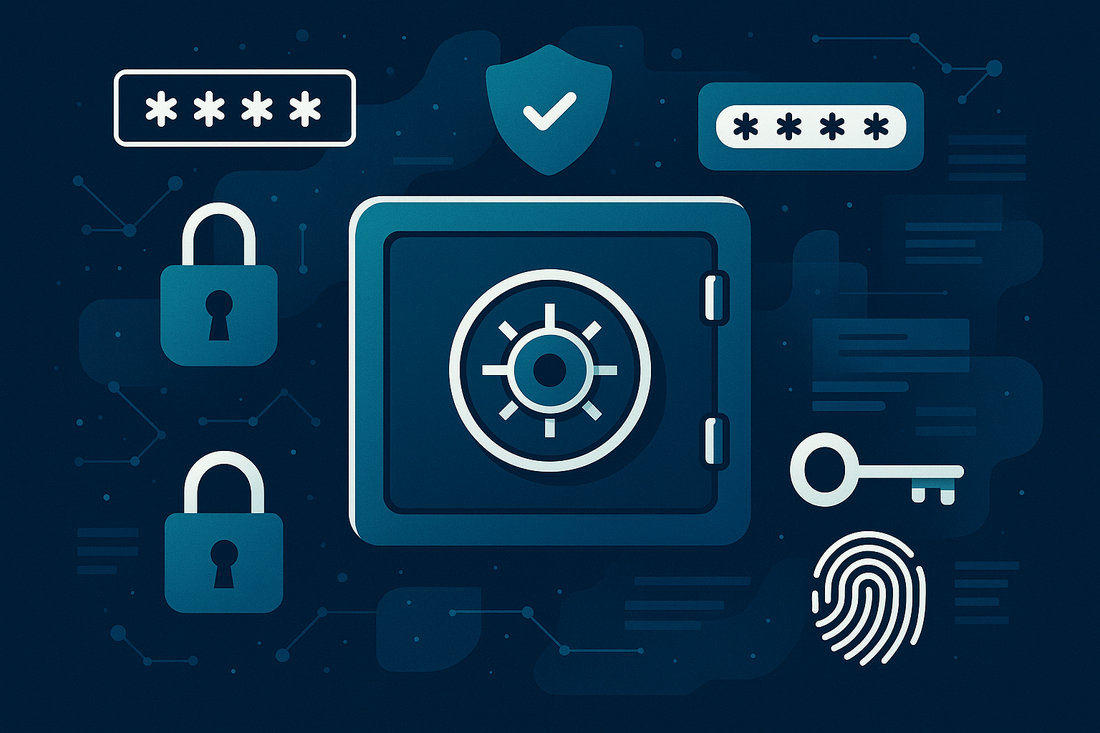
Password Managers - Protect Sensitive Data
Michael FosterShare
In today interconnected digital landscape, password security has become one of the most critical challenges facing individuals and organizations worldwide.
The average person now manages over 100 different online accounts, each requiring unique credentials to maintain proper security standards. This exponential growth in digital touchpoints has created an overwhelming burden that traditional password management approaches simply cannot handle effectively.
Password managers represent a revolutionary solution to this modern security challenge, offering sophisticated tools that generate, store, and automatically fill complex passwords across all digital platforms.
When combined with robust infrastructure security measures like Trustico® SSL Certificates, password managers form a comprehensive defense strategy that protects sensitive data from unauthorized access and cyber threats.
The Critical Role of Password Security in Digital Infrastructure
Password-related security breaches continue to plague organizations across all industries, with weak or reused passwords serving as the primary entry point for cybercriminals. Research consistently shows that many data breaches involve compromised passwords, making password security a fundamental component of any comprehensive cybersecurity strategy.
The complexity of modern password requirements has created a paradox where users must balance security with usability. Strong passwords require a combination of uppercase letters, lowercase letters, numbers, and special characters, often with minimum length requirements of 12 characters or more. Remembering dozens of such passwords becomes virtually impossible without proper tools and systems in place.
This challenge becomes even more pronounced in enterprise environments where employees must access multiple systems, applications, and services throughout their workday.
Without proper password management solutions, organizations face increased risks of security incidents, productivity losses, and compliance violations that can result in significant financial and reputational damage.
How Password Managers Transform Digital Security Practices
Password managers fundamentally change how individuals and organizations approach credential security by automating the most challenging aspects of password management. These sophisticated tools generate cryptographically secure passwords that meet or exceed industry security standards, eliminating the human tendency to create weak or predictable passwords.
Modern password managers utilize advanced encryption algorithms to protect stored credentials, ensuring that even if the password manager database is compromised, the actual passwords remain unreadable without the master password. This encryption typically employs AES-256 standards, the same level of protection used by government agencies and financial institutions for their most sensitive data.
The convenience factor cannot be overstated, as password managers automatically fill login credentials across websites and applications, eliminating the need for users to remember or manually type complex passwords. This automation not only improves security but also enhances productivity by reducing the time spent on authentication processes throughout the workday.
Essential Features of Enterprise-Grade Password Management Solutions
Professional password managers offer a comprehensive suite of features designed to meet the complex security requirements of modern organizations. Multi-factor authentication integration ensures that access to the password manager itself requires additional verification beyond the master password, creating multiple layers of security protection.
Secure password sharing capabilities allow teams to collaborate effectively while maintaining security standards. Rather than sharing passwords through insecure channels like e-mail or messaging applications, password managers provide encrypted sharing mechanisms that maintain audit trails and access controls.
Advanced password managers include security monitoring features that continuously scan for compromised credentials across known data breaches. When a password is found in a breach database, the system immediately alerts users and prompts them to change the affected credentials, preventing potential unauthorized access before it occurs.
Administrative controls enable organizations to enforce password policies across their entire user base, ensuring consistent security standards regardless of individual user preferences or technical knowledge. These controls can mandate password complexity requirements, enforce regular password rotations, and prevent the reuse of previous passwords.
Integration with SSL Certificate Infrastructure for Complete Security
Password managers work most effectively when deployed within a comprehensive security infrastructure that includes proper SSL Certificate implementation. Trustico® SSL Certificates provide the encrypted communication channels that protect password data during transmission between users and password management services, which are especially useful when dealing with hosted and remote password management services.
The combination of strong password management and SSL Certificate protection creates a multi-layered security approach that addresses both authentication and data transmission vulnerabilities. When users access their password managers through SSL-secured connections, their master passwords and stored credentials remain protected from interception and man-in-the-middle attacks.
Trustico® offers both Trustico® branded and Sectigo® branded SSL Certificates that provide the robust encryption necessary to support enterprise password management deployments. These SSL Certificates ensure that all communications between password management clients and servers maintain the highest levels of security and integrity.
Business Benefits of Implementing Password Management Solutions
Organizations that implement comprehensive password management solutions experience significant improvements in both security posture and operational efficiency. The reduction in password-related support tickets alone can result in substantial cost savings, as IT departments spend less time helping users recover forgotten passwords or resolve account lockout issues.
Compliance requirements in industries such as healthcare, finance, and government often mandate specific password security standards that are difficult to achieve without proper management tools. Password managers help organizations meet these regulatory requirements by enforcing consistent password policies and maintaining detailed audit logs of credential access and usage.
The productivity gains from automated password filling and reduced authentication friction can be substantial across large organizations. Employees spend less time dealing with password-related issues and more time focusing on their core responsibilities, resulting in improved overall business performance.
Addressing Common Password Manager Security Concerns
Despite their obvious benefits, some organizations hesitate to implement password managers due to concerns about creating a single point of failure. However, modern password managers are designed with multiple security layers that make them significantly more secure than traditional password management approaches.
The encryption used by reputable password managers ensures that even the service providers themselves cannot access user passwords. This zero-knowledge architecture means that password data remains encrypted at all times, with decryption only possible using the user master password that never leaves the user device.
Regular security audits and penetration testing by independent security firms help ensure that password management solutions maintain the highest security standards. Leading password manager providers publish detailed security whitepapers and undergo third-party security certifications to demonstrate their commitment to protecting user data.
Best Practices for Password Manager Implementation
Successful password manager deployment requires careful planning and adherence to security best practices. Organizations should begin with a comprehensive assessment of their current password security practices and identify the specific requirements that their password management solution must address.
Master password security represents the most critical aspect of password manager implementation. Users must create strong, unique master passwords that they can remember without writing down or storing in insecure locations. Multi-factor authentication should always be enabled for password manager accounts to provide additional protection against unauthorized access.
Regular security training helps ensure that users understand how to properly utilize password management tools and recognize potential security threats. This training should cover topics such as identifying phishing attempts, understanding the importance of keeping password manager software updated, and following proper procedures for sharing credentials with authorized team members.
The Future of Password Security and Authentication
The evolution of password security continues with emerging technologies such as biometric authentication, hardware security keys, and passwordless authentication systems. However, password managers remain essential components of comprehensive security strategies, even as these new technologies become more widespread.
Integration capabilities with emerging authentication methods ensure that password managers will continue to play important roles in future security architectures. Many password managers now support hardware security keys and biometric authentication as additional factors, creating even stronger security combinations.
The trend toward zero-trust security models emphasizes the importance of strong authentication mechanisms across all system access points. Password managers provide the foundation for implementing zero-trust principles by ensuring that every access attempt is properly authenticated with strong, unique credentials.
Implementing Trustico® SSL Certificates with Password Management Solutions
The deployment of password management solutions requires robust SSL Certificate infrastructure to protect all communications and data transfers. Trustico® SSL Certificates provide the encryption foundation that ensures password managers can operate securely across diverse network environments and device types.
Whether organizations choose Domain Validation (DV), Organization Validation (OV), or Extended Validation (EV) SSL Certificates, Trustico® offers comprehensive solutions that meet the security requirements of password management deployments. Our SSL Certificates support the latest encryption standards and provide the trust indicators that users expect when accessing security-critical applications.
Many commercial password managers include the full software solution and an SSL Certificate may not be required, however, when developing or implementing custom solutions it remains fundamental to secure all communications with an SSL Certificate. Many organizations choose to implement their own solutions and not rely upon commercial solutions, that's a choice involving many factors - such as company security policy.
Conclusion : Building Comprehensive Digital Security with Password Managers and SSL Certificates
Password managers represent an essential tool in the modern cybersecurity toolkit, addressing one of the most fundamental challenges facing individuals and organizations in the digital age. The combination of automated password generation, secure storage, and convenient access creates a security solution that is both highly effective and user-friendly.
When implemented alongside robust Trustico® SSL Certificates, password managers become part of a comprehensive security strategy that protects against a wide range of cyber threats. This multi-layered approach ensures that both authentication credentials and data transmissions remain secure against evolving security challenges.
The investment in proper password management solutions pays dividends through improved security posture, enhanced productivity, and reduced operational overhead. Organizations that embrace these tools position themselves to meet current security challenges while building the foundation for future security requirements and emerging authentication technologies.



